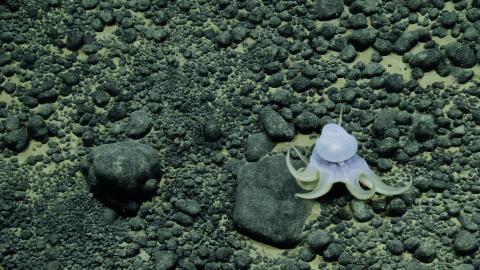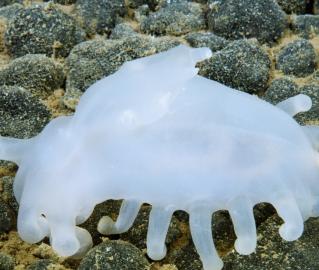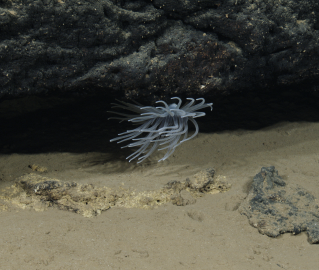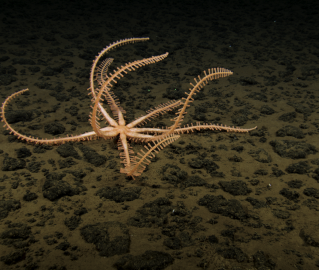The MxD SeaCam: A Journey to a New Standard in Subsea Imaging
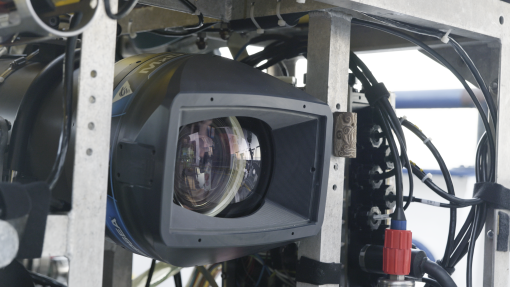
During the NA176 expedition to explore deep-sea habitats of the Cook Islands, the Corps of Exploration aboard E/V Nautilus welcomes a new piece of ocean exploration technology: DeepSea Power & Light’s MxD SeaCam®! This camera is a broadcast-grade, high-performance 4K imaging system engineered for subsea exploration, scientific research, and documentary filmmaking. During the expedition, the team of engineers and scientists will push the MxD SeaCam deeper than it has ever been deployed and integrate the camera with two of OET’s ROV systems – the 4000 m-rated ROV Hercules and 6000 m-rated ROV Little Hercules.
Developed through a multi-year collaboration between the Monterey Bay Aquarium Research Institute (MBARI) and DeepSea Power & Light, the MxD SeaCam integrates advanced imaging capabilities with a custom mechanical design that meets the rigorous demands of subsea filming. After its initial conception as a high-end scientific imaging system, the MxD SeaCam underwent a rigorous development process, overcoming numerous design and integration challenges to emerge as a studio-grade platform capable of capturing the deep ocean with exceptional clarity, precision, and reliability.
Project Genesis and Objectives
At the project’s inception, the scientific community lacked a modern imaging system that could advance our understanding of the ocean with higher detail and clarity than what could be achieved with available systems. Existing deep-sea camera systems used for research relied on aging CCD sensors and lacked the resolution and optical fidelity required for modern scientific applications. Mark Chaffey of MBARI initiated the concept for a next-generation camera system and sought industrial partners to co-develop the housing and optics. DeepSea Power & Light was selected based on prior experience with high-pressure dome port housings and recent work on an 11,000-meter-rated system for crewed submersibles.
The initial concept was shaped through early conversations between Chaffey, Paul Remijan of Fathom Imaging, and DeepSea engineers in 2019 and 2020. Together, they worked through the engineering trade-offs and system architecture that would ultimately define the MxD SeaCam. The goal was not only to meet MBARI’s scientific imaging needs but also to create a platform that could be commercialized and adapted for broader use.
Design Decisions and Material Selection
Much of the MxD’s design was guided by the system requirements laid out in MBARI’s original 4K camera housing solicitation. One of the most critical engineering challenges was the design of the dome port housing. To mitigate risk and ensure reliability, DeepSea opted for conventional materials with proven performance under pressure.
- Titanium was selected as the housing material due to its strength-to-weight ratio and corrosion resistance. Alternatives like aluminum and steel were ruled out; aluminum lacked sufficient strength, and steel was too heavy for integration with existing pan-and-tilt systems.
- The Sony HDC-P50 was chosen after extensive research by MBARI. Its compact form factor and remote operation capabilities made it ideal for subsea deployment. The camera’s three 2/3” CMOS global shutter sensors—dedicated to red, green, and blue channels—offered a balanced trade-off between image quality and system size. Larger sensors would have required impractically large optics and housing.
- The telemetry system and 12G-SDI signal handling were co-architected by Aaron Steiner of DeepSea and Mark Chaffey of MBARI to support high-bandwidth video transmission from the seafloor to the surface vessel. These decisions were made with future scalability and commercial viability in mind. DeepSea engineers have since developed an advanced modular operator interface and additional custom electronics for handling telemetry and communications over a single fiber-optic data link.
Engineering Challenges and Solutions
The development of the MxD SeaCam faced several complex engineering challenges and unexpected social setbacks.
Camera Body Rework
The Sony HDC-P50 camera body was selected for its compact design and broadcast-grade imaging capabilities. However, even with the relatively small form factor of the camera, it would not be small enough to fit the hard limits set on the size and volume of the MxD housing. The MxD needed to be sized to fit existing subsea research and exploration if it were to fill the gap in subsea imaging technology. This meant that the overall camera body couldn’t be significantly larger than previous-generation solutions.
This limitation on size and weight meant the Sony camera needed to be repackaged within the chassis of the MxD. This process involved extensive simulation, thermal modeling, and precision mechanical design, but resulted in a more space-efficient solution.
Designing DeepSea’s Largest Dome Port Housing
A key design decision for the MxD and the main focus of the early months of development was how to size the glass dome port for the housing. The dome port’s size directly impacts image distortion and chromatic aberration – larger domes introduce less distortion. However, a larger dome will significantly increase the complexity and risk of the pressure housing design. It is a classic example of balancing competing engineering design pressures. The team placed an upper limit on the seat stress of the dome based on DeepSea’s previous experience designing optical ports for 11km depths. This provided enough constraints to limit the possible solutions. After many iterations and a few false starts, the team arrived at an optimal solution that minimized the dome size but left enough flexibility in the corrector optics design envelope to achieve diffraction-limited performance. Based on the simulation data, the image through the Canon lens would be as good underwater behind the dome port as it was in the air.
The final dome port ended up with a 104 mm outer radius and a 24 mm center thickness, making it by far the largest dome DeepSea had ever produced. Similarly, the 7000 m-rated housing, designed by Jason Buss, is the largest camera housing DeepSea has ever developed. Manufacturing the oversized dome port required a new supply chain for the optical glass, along with the multiple coatings and surface treatments needed to maximize performance and toughness of the dome. Meanwhile, the metal housing elements would prove to stretch the limits of DeepSea’s in-house machine shop capabilities.
The final challenge for the housing was to validate the design and test the new parts. Given the cost and risk of deploying an advanced imaging system like the MxD, the housing must have the highest operational confidence. However, given the size of the housing, DeepSea had to design and build a custom 12” diameter pressure chamber capable of performing precise pressure tests at high rates and high cycles. The final dome and housing design would be pressure cycled to its equivalent operating pressure over 10,000 times, providing in-situ data that validated the simulation models.
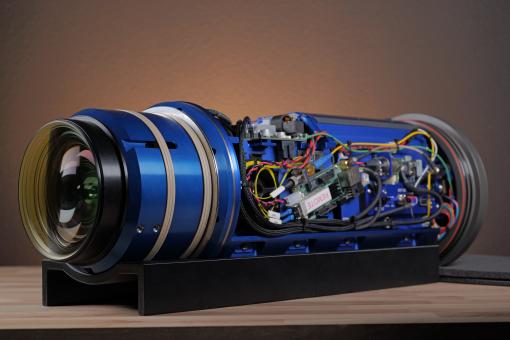
The Global Pandemic and Corrector Optics Setbacks
The design phase began in late 2019, just prior to the outbreak of the COVID-19 global pandemic. With contributors located across the U.S., the team adapted to remote workflows, relying heavily on teleconferencing and distributed prototyping.
After months of simulation and fabrication delays due to pandemic-era lockdowns, the first prototype camera failed to meet all expectations. While the mechanical design, thermal management, and telemetry systems all worked flawlessly, the team identified issues with the optics, including poor corner sharpness, focus inconsistencies, and color separation.
Upon investigation and extensive bench testing, the team discovered that the parameters used to model the Canon broadcast lens in the MxD were flawed. This setback ultimately led to a breakthrough: Canon provided a dynamic model of the lens assembly, enabling Paul Remijan to design a second-generation corrector: the MKII. This revised design delivered superior image quality, reduced distortion, and a wider field of view. Without the initial failure, the team may not have gained access to the improved lens data that made the MKII possible, allowing the MxD SeaCam to realize its full potential.
Collaboration and Commercial Evolution
The first two MxD units were developed in close partnership with MBARI and Fathom Imaging. DeepSea produced the camera housings, and Fathom Imaging built the optical corrector assembly. Meanwhile, MBARI built the internal chassis and topside controls tailored to their vehicles and operations. MBARI also handled final integration of the chassis, housing, and corrector assembly before testing the system in their on-site 10x10x10 m test tank.
Following the successful deployment of the first-generation units, DeepSea refined the design for broader commercial applications. Key improvements include:
- Extended Depth Rating: The original MBARI units were rated to 4,000 meters. DeepSea’s commercial version maintains the same form factor but is qualified to a full 7,000 meters, expanding operational coverage from ~50% to 99% of the seafloor.
- Power Supply Flexibility: A redesigned internal power supply supports a wide input range (20–48 VDC), improving compatibility with various vehicle platforms.
- Dual 12G-SDI Outputs: Both outputs from the Sony HDC-P50 are utilized, enabling redundancy and support for high-frame-rate video modes.
- Ethernet-Based Control: The system architecture is built around networked communication, allowing remote access to camera settings and diagnostics via a web interface. The operator panel is also web-configurable.
- Auxiliary Interfaces: Additional ports include RS-232/485 serial, spare Ethernet, and selectable power options, enabling future expansion and integration of accessories.
- Modular Operator Panel: The control interface features customizable buttons, fine-tuned zoom and focus rate controls, and a 3-axis joystick for pan-and-tilt operation.

Impact and Future Outlook
At its core, the MxD SeaCam is designed to empower the people who use it. Scientists and filmmakers working in the deep sea often face hard limits on access, visibility, and resolution. The MxD addresses these limitations by offering a platform that is not only technically advanced but also operationally efficient.
To ensure the MxD SeaCam was ready for deep-sea deployment, DeepSea conducted extensive on-site testing. From qualification pressure testing on the first 7,000 m rated housing to full-system poolside tests that simulated 10 km of fiber between the MxD camera and topside controls, the system handled everything the DeepSea team could think to throw at it.
The camera’s maiden voyage aboard the E/V Nautilus marks a symbolic milestone. Operated by the Ocean Exploration Trust, the Nautilus carries forward the legacy of its founder, Dr. Robert Ballard, whose discoveries, including the wreck of the Titanic and hydrothermal vent ecosystems, have shaped public understanding of the ocean. Many of the engineers and scientists involved in the MxD project were inspired by Dr. Ballard’s work. To debut the MxD on this platform is not only a technical validation but also a contribution to a lineage of exploration that has captivated global audiences.
From a research perspective, the MxD SeaCam’s capabilities represent a step change. Doubling the resolution, zoom range, and operational depth compared to its predecessors, the system opens new frontiers for discovery. As one engineer put it, “Breakthroughs are made at the limits of what we can observe.” The MxD pushes those limits, enabling access to nearly the entire seafloor and capturing phenomena with unprecedented clarity.
Beyond its core specifications, the MxD includes features that hint at future potential. With additional topside equipment and updates to the chassis, DeepSea plans to demonstrate high-frame-rate video at 240 fps at 4K resolutions and 480 fps in full HD, ideal for capturing fast-moving marine life or dynamic geological processes.
DeepSea is also developing a roadmap for future enhancements. These include expanded topside control features, integrated logging and monitoring tools, and support for multi-camera configurations. A compact, self-contained operator controller is in development for use in crewed submersibles, eliminating the need for a rack-mounted telemetry multiplexer.
Looking back, the MxD SeaCam stands as a capstone project for many of the people involved. Mark Chaffey delayed his retirement to see it through, viewing it as a cornerstone of his legacy at MBARI. For the DeepSea team, the project represents a rare opportunity to design and build something just because it was worth doing, not because of commercial need and ROI projections. It’s a product that reflects years of accumulated expertise, collaboration, and a shared commitment to advancing ocean technology.
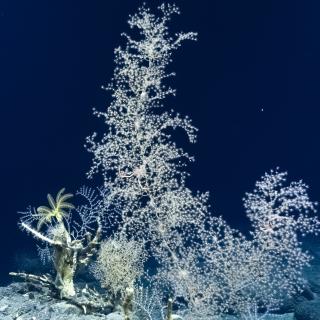
Deep-Sea Habitats of the Cook Islands
This 21-day expedition will utilize the ROV, mapping, and telepresence systems of E/V Nautilus to explore previously unsurveyed deep-sea priority areas identified by the management and science community in the Cook Islands.
